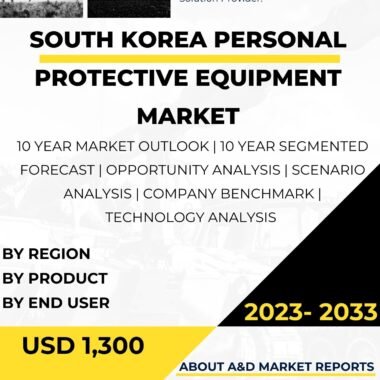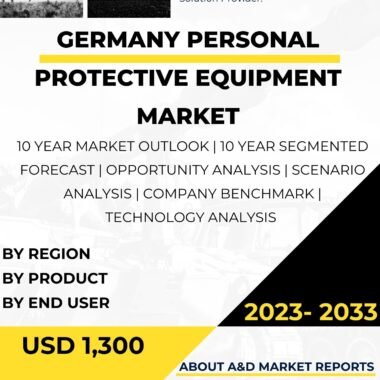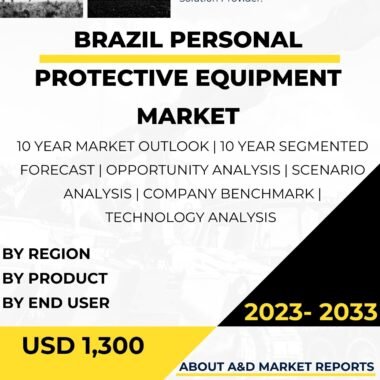Description
United States Personal Protective Equipment (PPE) plays a crucial role in safeguarding the health and safety of workers and first responders across various industries and sectors. PPE encompasses a range of equipment and clothing designed to protect individuals from occupational hazards, environmental contaminants, and infectious agents. As a critical component of occupational health and safety measures, PPE ensures that workers can perform their tasks safely, reducing the risk of injuries and illnesses.
The COVID-19 pandemic brought global attention to the importance of PPE in protecting frontline healthcare workers and the general population. PPE such as face masks, gloves, gowns, and face shields became essential in preventing the spread of the virus and mitigating its impact on public health.
For healthcare workers, PPE is a primary defense against infectious diseases. It includes various types of respirators, such as N95 masks, which filter out airborne particles, and surgical masks, which protect against droplets and splashes. Additionally, gloves, gowns, and protective eyewear offer a barrier against potential exposure to infectious materials.
The demand for PPE surged during the COVID-19 pandemic, putting stress on supply chains and prompting the U.S. government to take action to increase production and distribution. The Strategic National Stockpile, a repository of medical supplies maintained by the U.S. Department of Health and Human Services, played a crucial role in distributing PPE to areas with high infection rates.
In addition to healthcare settings, PPE is vital in various industries and occupations where workers face specific hazards. Construction workers, for example, require PPE such as hard hats, safety glasses, high-visibility vests, and steel-toed boots to protect against falls, impact, and other potential risks.
Similarly, in industrial settings, workers handling hazardous chemicals or operating heavy machinery may need specialized PPE, such as chemical-resistant suits, respirators, and ear protection, to reduce exposure to dangerous substances and noise.
Firefighters also rely on PPE to protect against heat, flames, and toxic smoke during firefighting operations. Fire-resistant clothing, helmets, gloves, and self-contained breathing apparatuses (SCBAs) are essential components of their protective gear.
In the agricultural sector, farmers and farmworkers use PPE to safeguard against exposure to pesticides, fertilizers, and other chemicals. Items such as chemical-resistant gloves, eye protection, and respiratory masks are essential in minimizing the risk of chemical-related illnesses.
The U.S. Occupational Safety and Health Administration (OSHA) sets regulations and standards for PPE usage in various industries. OSHA requires employers to conduct hazard assessments and provide appropriate PPE to workers based on the identified risks.
However, ensuring proper PPE usage requires more than just providing the equipment; it also involves training workers on the correct usage, maintenance, and disposal of PPE. Proper fit testing for respirators and regular equipment inspections are critical to ensuring the effectiveness of PPE.
In emergency response scenarios, such as natural disasters, hazmat incidents, or terrorist attacks, first responders rely heavily on PPE to carry out their duties safely. Firefighters, law enforcement officers, and emergency medical personnel are equipped with specialized gear to protect against the unique hazards they may encounter.
The development of advanced PPE technologies continues to evolve, driven by the need for better protection and improved comfort for users. Nanotechnology and advanced materials have led to lighter, more flexible, and breathable protective clothing without compromising performance.
Innovations in PPE have also been accelerated by the lessons learned from the COVID-19 pandemic. Research and development efforts have focused on improving filtration capabilities, antimicrobial properties, and reusability of PPE items like masks and gowns.
Furthermore, wearable technology is being integrated into PPE to monitor vital signs, track exposure to hazardous substances, and enhance situational awareness for first responders and industrial workers.
While PPE is essential in mitigating occupational hazards, it is not a substitute for other safety measures. The hierarchy of controls, as outlined by OSHA, prioritizes eliminating or reducing hazards at the source, engineering controls, administrative controls, and then PPE as a last resort.
Despite the efforts to promote the proper use of PPE, challenges persist. The improper use or non-compliance with PPE protocols can undermine its effectiveness and lead to increased risks of injuries or illnesses.
Additionally, the COVID-19 pandemic exposed vulnerabilities in the global supply chain for PPE, prompting calls for domestic production capabilities to reduce reliance on foreign suppliers during emergencies.
In response to the pandemic, many U.S. companies shifted their production to manufacture PPE, showcasing the nation’s adaptability and resilience in times of crisis.
To enhance national preparedness for future emergencies, public and private sectors are collaborating to develop strategies for maintaining adequate PPE reserves, ramping up production capacity, and improving distribution logistics.
In conclusion, United States Personal Protective Equipment is a critical aspect of ensuring the safety and well-being of workers and first responders across various industries. It encompasses a diverse range of equipment and clothing designed to protect against occupational hazards, environmental contaminants, and infectious agents.
During the COVID-19 pandemic, PPE became a vital defense against the spread of the virus, highlighting its significance in public health emergencies. Properly selecting, using, and maintaining PPE is essential to ensure its effectiveness in minimizing risks and preventing injuries and illnesses.
Efforts to enhance PPE technologies, domestic production capabilities, and supply chain resilience will strengthen the nation’s ability to respond to future challenges effectively. Moreover, a continued focus on PPE training, compliance, and integration with other safety measures will contribute to a safer and healthier workforce and enhance national readiness for emergency situations.




